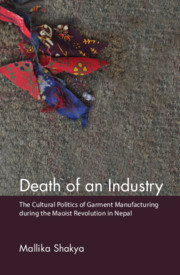 Death of an Industry
Death of an Industry Book contents
- Frontmatter
- Dedication
- Contents
- Figures and Table
- Abbreviations
- Key Names
- Acknowledgements
- 1 Situating the Idea: Industry, Society and Development
- 2 Nepal and Garments
- 3 A Garment Industry Ecosystem
- 4 The Normality of Garment Making
- 5 The MFA Expiry: A Garment Tsunami
- 6 Workers and Unions: Ethnicity and Class
- 7 Reconstituting the Garment Afterlife
- Bibliography
- Index
3 - A Garment Industry Ecosystem
Published online by Cambridge University Press: 08 July 2018
- Frontmatter
- Dedication
- Contents
- Figures and Table
- Abbreviations
- Key Names
- Acknowledgements
- 1 Situating the Idea: Industry, Society and Development
- 2 Nepal and Garments
- 3 A Garment Industry Ecosystem
- 4 The Normality of Garment Making
- 5 The MFA Expiry: A Garment Tsunami
- 6 Workers and Unions: Ethnicity and Class
- 7 Reconstituting the Garment Afterlife
- Bibliography
- Index
Summary
In this chapter, I map the industrial ecosystem within which garment workers and their various counterparts live and work. The industrial spatiality I discuss here sets the stage for what follows in chapters 4 and 5: a shop floor ethnography of garment manufacturing from apparent normalcy to crisis. My proposition of the industrial ecosystem draws on Michael Porter's (1990) idea of industrial clusters – spatial coordination underpinning business networks and alliances – and its curious overlap with anthropology in acknowledging that every society has its own characteristic sets of rules, norms, and concepts; or in other words, culture. From this acknowledgement emerges a policy proposition: programmes of industrial development should build on societal rules about trust and entrepreneurship, instead of blindly relying on abstract hypotheses about the supply-demand equilibrium, which do not acknowledge human agency in industrialization.
Porter's idea of ‘industrial clusters’ triggered two sets of responses from global economic thinkers. One set of responses, largely negative, was from a group of economists, including those linked to the International Financial Institutions (IFIs), who protested the notion that ‘micro’ issues, such as firm coordination, mattered more than the all-encompassing ‘macro’ forces of supply and demand. At the heart of this debate lay the tricky notion of ‘rent-seeking’, or the phantom value generated by entities with lobbying power, where resources are channelled to specific entities and sectors even when the market rationale for doing so does not exist (Krueger, 1974). After all, the IFIs’ Structural Adjustment programs of the 1980s and 1990s had drawn on the concept of rent-seeking to prescribe an entrenched public policy position for governments in developing countries: their job was to dismantle the barriers of entry and exit for capital to enter any industrial sector, in order to ensure that scarce resources could move freely to the best industrial sectors, and, within those sectors, to the best firms.
The other response to the idea of the industrial cluster was a positive one, and gained support from some unexpected quarters of social science – such as anthropology – among those looking for ways to counter the neoliberal hegemony of free markets, which advised states to withdraw from industry regulation to let the anonymous forces of supply and demand take charge.
- Type
- Chapter
- Information
- Death of an IndustryThe Cultural Politics of Garment Manufacturing during the Maoist Revolution in Nepal, pp. 35 - 57Publisher: Cambridge University PressPrint publication year: 2018
